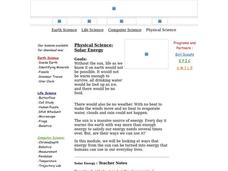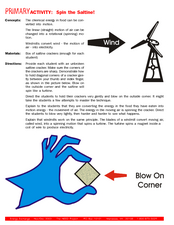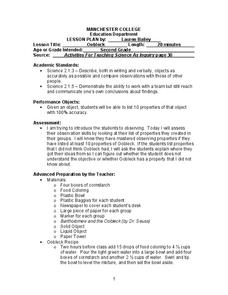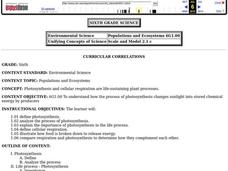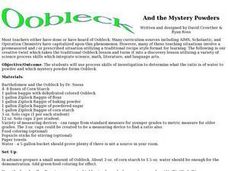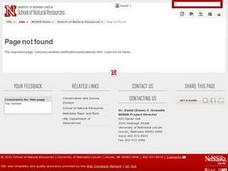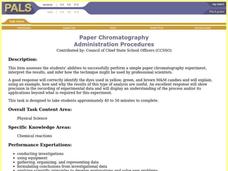Curated OER
Population Density
Middle schoolers use the scientific method to conduct an experiment and use varied methods to gather background information. They correctly use lab equipment and prepare tables and graphs that organize, conclude, and present their...
Curated OER
Introduction to Digestion: What Happens to a Hamburger?
Learners explore the human body by analyzing how food is absorbed. In this food digestion lesson, students utilize health vocabulary terms by participating in a guessing game activity. Learners discuss their own eating habits and conduct...
Curated OER
Microbe Experimentation: Sour Milk
Sixth graders design and conduct an experiment with milk to investigate how temperature affects bacteria growth. They, in groups, construct a hypothesis, perform the experiment and then record and present the results.
Curated OER
Microwave Introduction
Students take true and false pretest, and explore and practice basic principles of microwave cooking and how to use and care for it properly while preparing foods. Students watch teacher demonstration and then prepare their own bags of...
Curated OER
Solar Energy
Young scholars investigate solar energy. They explore ways that energy from the sun can be turned into energy that humans can use in our everyday lives. In various experiments, they explore the effect of clouds and dust on photovoltaic...
Curated OER
Animal Life Cycles
Students participate in numerous activities to gather information about parts of the life cycle. In this life science lesson plan, the teacher choose from a number of activities to create or support an interdisciplinary unit about the...
Curated OER
ABOUT ALL YOU CAN EAT: Superfoods
Young scholars trace back through time to see how the nutritional value of food consumed was enhanced. In this nutrients lesson students complete several activities that show the mass of food, and its PH value.
Curated OER
Spin the Saltine!
Students investigate chemical energy. In this physical science lesson, students blow on saltine crackers to demonstrate how chemical energy in food can be converted to motion. Students compare the saltine cracker experiment to how...
Curated OER
Oobleck
Second graders observe the properties of Oobleck. In this science and observation lesson, 2nd graders examine Oobleck and make a list of 10 properties that they notice. They explain their observations.
Curated OER
How Does a Green Plant Grow?
Students examine how a seed grows, and design an experiment to explore this concept. They make predictions, conduct the experiment, record the results, and interpret the results.
Curated OER
Photosynthesis
Sixth graders are introduced to the process of photosynthesis by discussion and then by participating in an experiment. They then answer questions as independent practice project.
Curated OER
Check Out Lights and Shields with Beads
Students explore Ultraviolet detecting beads and conduct several investigations with them. In this investigative instructional activity students participate in an experiment to see the harmful effects of UV light and discuss their...
Curated OER
Lesson 3: Life Cycle of Brassica Plants
Students investigate the life cycle of brassica plants. For this science lesson, students observe each stage in the life cycle of their plant. Students record their observations and graph the data. Students
Curated OER
Oobleck and the Mystery Powders
Pupils listen to the book, "Oobleck," by Dr. Suess before experimenting with mystery powders. They determine the proper ratio of powder to liquid to make the Oobleck.
Curated OER
Predator-Prey Relationships
Learners understand ecological systems. They provide experiences to assist citizens to increase their sensitivity and stewardship for the environment.
Curated OER
Physical and Chemical Properties of Water
Students experiment with water as a component of suspensions, solutions, and heat conduction contributing to the use of food and the health and wellness of human beings.
Curated OER
Earth's Atmosphere and Temperature
Pupils explore the layers of earth's atmosphere and conduct an experiment to identify carbon dioxide. They construct models using styrofoam to represent molecules in the atmosphere's layers. To discover how sunlight efffects...
Curated OER
Recyclers Revisited
Fifth graders observe their plant experiments that they started in a previous lesson and examine the role of decomposers in the nitrogen cycle. Two weeks after they set up a worm terrarium, they analyze any changes they observe, and...
Curated OER
Energy/Light/Heat/Sound
Fourth graders study the properties of heat in this series of lessons. They discuss sources of heat and experiment to determine its properties. They identify insulators and conductors by measuring temperatures, and graphing their data....
Curated OER
What's the Difference Between Concentration and Solubility?
Students discuss the difference between concentration and solubility as well as examine the difference in a hands-on activity. Using water and table salt, they experiment with solubility. They create different concentrations using water...
Curated OER
Vegetable Faces: A Guiseppe Archimboldo Portrait Study
Students create drawings of vegetable faces.In this early childhood lesson plan, students identify various vegetables, which they use as models to create drawings. Students experiment with the vegetable drawings by adding faces to their...
Curated OER
Products from Petroleum
Students examine products that are petroleum based. In this petroleum product lesson, students examine a display of petroleum based products. They discuss the products that are made from crude oil and conduct an experiment that...
Curated OER
Paper Chromatography
Small groups of learners perform paper chromatography to separate food dyes into their component colors. Students perform the experiment and collect, organize, and represent their data to form an explanation of their outcomes. Learners...
Curated OER
A Day at the Beach-Why Did We Do It?
Learners investigate pollution at the beach. In this environmental lesson, students participate in a beach clean-up and calculate the weight of the debris collected. Learners write a reflection in their journal about their beach clean-up...




